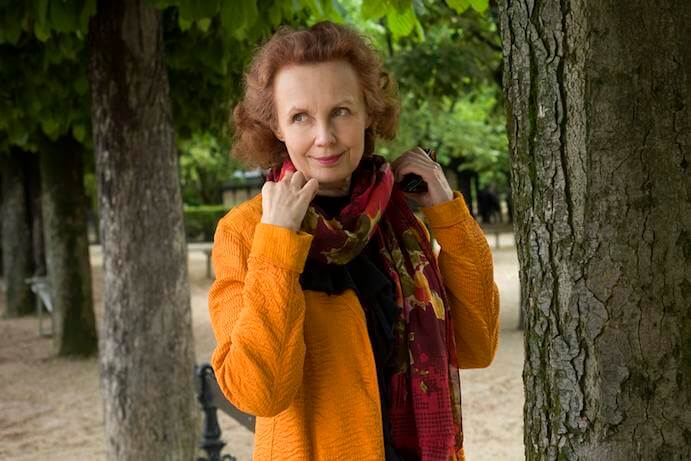November 25-26, 2015 in Berlin, Germany, was the premiere of the 2013 version of Kaija Saariaho’s La Passion de Simone for soprano, choir, and chamber orchestra. The Berliner Philharmoniker’s artist-in-residence program (in cooperation with the Deutsche Oper Berlin) presented this performance, which involved members of the Berliner Philharmoniker’s Akademie Orchester (training orchestra) conducted by Duncan Ward; a vocal quartet from the Rundfunkchor Berlin consisting of soprano Isabelle Voßkühler, contralto Christine Lichtenberg, tenor Jan Remmers, and bass Wolfram Taßmer; soprano soloist Julia Bullock; staging by Peter Sellers; and assistant directing by the American dancer and choreographer Michael Schumacher. All performances took place in the Tischlerei (carpentry workshop) of the Deutsche Oper Berlin.
Saariaho describes La Passion de Simone in her program note as a “musical journey in fifteen stations,” exploring the life and philosophy of Simone Weil. Weil was an upper-class Parisian philosopher, social activist, and catholic mystic who supported the republic in the Spanish civil war, fought for the rights of Renault factory workers, and eventually starved herself to death in an English hospital in solidarity with the victims of Hitler’s dictatorship. Saariaho has long been interested in the life and philosophies of Simone Weil, listing Weil’s book Gravity and Grace as one of the few things she took with her when she left her native Finland to study composition in Germany.

Kaija Saariaho– Photo by Priska Ketterer
Amin Maalouf’s libretto explores the themes of political activism and social justice in such a way that the immense contrast between a single small human figure and over-arching themes of philosophy and mysticism become tragically apparent. The text is set in fifteen stations, reminiscent of the station of the cross from the catholic tradition (of which there are also fifteen when the resurrection of Jesus is included as the final station). This structure is what most closely ties the work to the traditional oratorio.
The staging and lighting for this production was minimalist, consisting of a raised stage upon which Julia Bullock performed with the orchestra to the right and the vocal quartet behind. On the raised stage was a screen with what appeared to be a florescent light tube behind it, each lit with changing colored lights. The lighting changed in time with the music to underscore dramatic moments, sometimes with a startlingly strong effect. The coordination of lighting changes and conducting was very well timed, as were the moments when the Bullock’s actions lined up exactly with motives and gestures in the chamber orchestra.
Saariaho’s score lends to the drama and tension of the libretto through the use of sustained dissonance and the juxtaposition of contrasting textures and harmonies. The tragic arch of Simone Weil’s life is very much apparent in Saariaho’s use of harmonic tension to build a sense of the aspects of Weil’s life that correspond to the idea of a passion play — her advocacy, agency, suffering, and ultimately, her death. The orchestra is in many ways as important as though it were a character in its own right: it creates impassioned outbursts and quiet introspection with equal grace, tracing Weil’s life with great attention to details of musical expression.
Saariaho La Passion de Simone– Photo by Ruth Walz
The Berliner Philharmoniker Academy Orchestra brought an intense energy to their performance; which at times I wanted much more of from the vocalists. The quartet from the Rundfunkchor excelled at adding subtleties of acting to the staging, almost seeming to function as a human extension of the stage/set, which they were seated behind and used as a music stand for almost all of the performance. Soprano Julia Bullock was at times intense, but inconsistently so. She presented a solid performance, but her character and singing lacked a clear dramatic arch through the 75 minute score, and at times was out-staged by the more energetic chamber orchestra.
Twice there were unfortunate interruptions in the philosophical mood set by the music: once when an audience member’s cellphone rang loudly, accompanied by icy glares from all present, and again when someone used the nearby freight elevator with unfortunate timing. The performance was well received, with the entire cast and directors taking multiple bows during a minutes long round of applause provided by what appeared to be a nearly sold-out house.

